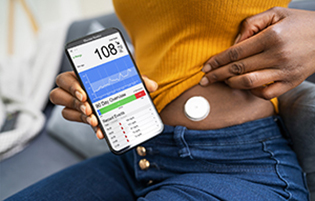What Is Type 2 Diabetes?
Type 2 diabetes is one of three main types of diabetes. People with type 2 diabetes either cannot make enough insulin or are unable to effectively use the insulin in their bodies' cell (or both). This leads to blood glucose levels that are very high. Approximately 90-95% of Americans with diabetes have this type.
Additionally, people with type 2 diabetes tend to have other co-existing conditions, such as high blood pressure (hypertension) and high cholesterol. These conditions can increase the risk of strokes, heart attacks and peripheral vascular disease.
What Causes Type 2 Diabetes?
The causes of type 2 diabetes are not exactly understood. There are a variety of risk factors that influence the chances of developing type 2 diabetes, including your genes and lifestyle. You can’t change some risk factors, such as your family history, age or ethnic background. But you can change risk factors related to your lifestyle, such as your eating habits, physical activity and your weight.
You are more likely to develop type 2 diabetes if you:
- Are overweight or obese
- Are age 45 or older
- Have a family history of diabetes
- Are Alaska Native, American Indian, Asian American, Black, Hispanic/Latino, Native Hawaiian, or Pacific Islander American
- Have high blood pressure
- Have a low level of HDL, or “good” cholesterol, or a high level of triglycerides, a type of fat found in your blood
- Have a history of gestational diabetes, diabetes that develops only during pregnancy
- Have a measure of your belly more than 102 cm in males or 90 cm in females
- Are not physically active
Type 2 diabetes typically occurs in people over the age of 30 who are overweight or obese. However, this type of diabetes is being seen in younger age groups due to increases in the number of children and young adults who are overweight and obese.
To see if your weight puts you at risk for type 2 diabetes, check the Body Mass Index (BMI) chart. BMI is a measure that shows if you’re overweight or obese based on your body weight and height.
What Are the Symptoms of Type 2 Diabetes?
There are various signs and symptoms of type 2 diabetes. You may not experience all at once, and they can appear quite suddenly. The symptoms may also be mild so that you don’t even notice them, which is why many people have the disease but are not aware of it. Signs and symptoms include:
- Increased thirst
- Increased urination (due to the high blood sugar, which passes through the kidneys to increase volume of urine)
- Feeling very hungry
- Feeling tired, fatigue and weakness
- Feelings of irritability and other mood changes
- Losing weight without trying (people with diabetes are unable to absorb and use the energy from sugar in the blood)
- Tingling or numbness in your hands or feet
- Dark rashes around your neck or armpits (known as acanthosis nigricans)
- Blurred vision
How Is Type 2 Diabetes Diagnosed?
Diabetes can be diagnosed by a health care provider based on a person’s symptoms and a blood test.
The specific diagnosis with type 2 diabetes can be made based on your risk factors (such as weight) and further blood tests that check for the autoantibodies that destroy your insulin-producing cells in type 1 diabetes. If the results show that you do not have the autoantibodies, you most likely have type 2 diabetes.
Find endocrine care in your area.
How Is Type 2 Diabetes Treated?
If you are diagnosed with type 2 diabetes, or if you are at risk or showing signs of prediabetes, these steps can help prevent, delay or manage the disease:
- Lose weight if you’re overweight or obese
- Eat fewer calories and focus on healthy foods such as whole grains, lean meats, fruits and vegetables (get Healthy Eating Tips)
- Increase the amount of physical activity you do
- Talk with your diabetes care team about any of your health problems and risk factors that may need treatment to manage
- Ask your diabetes care team about any medicines you take that might increase your risk, such as steroids and others
In addition to lifestyle modifications, medications can be used to manage type 2 diabetes if blood glucose levels are not maintained within normal range. They can:
- Increase the production of insulin from the pancreas,
- Decrease sugar production from the liver or
- Make the body more sensitive to insulin.
Several medications are now available in pill form or as an injection. Some diabetes medications can help you lose weight (in combination with diet and physical activity), which should be kept in mind when deciding on the course of treatment.
People with type 2 diabetes may need insulin to control their blood sugar, though they do not require it for survival since their bodies are able to produce at least small amounts. In these cases, insulin is used to supplement other diabetes medications.




